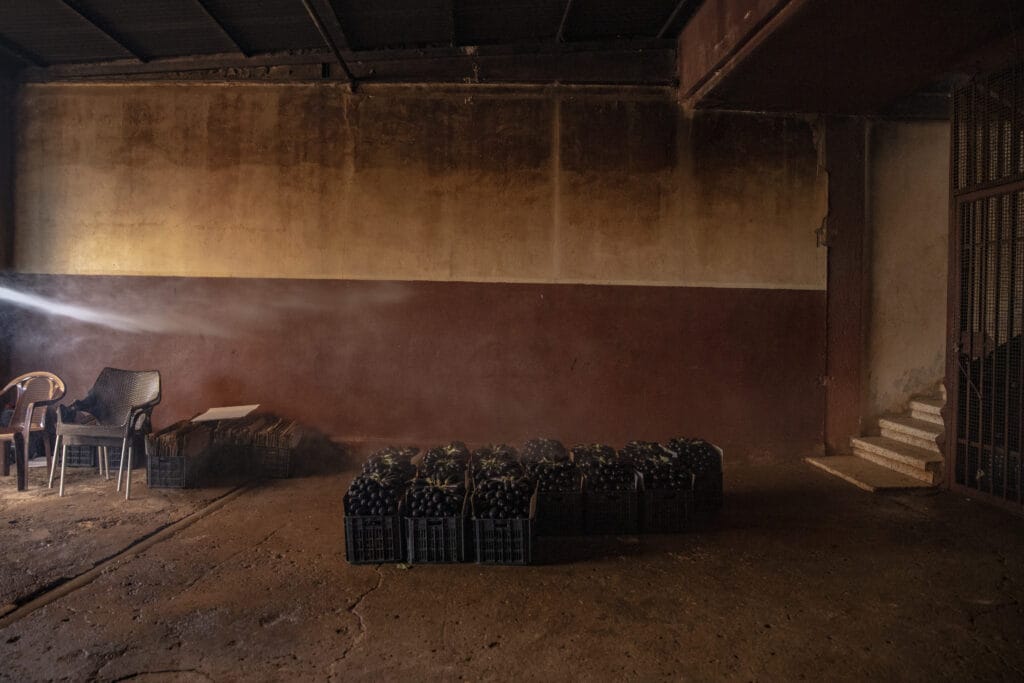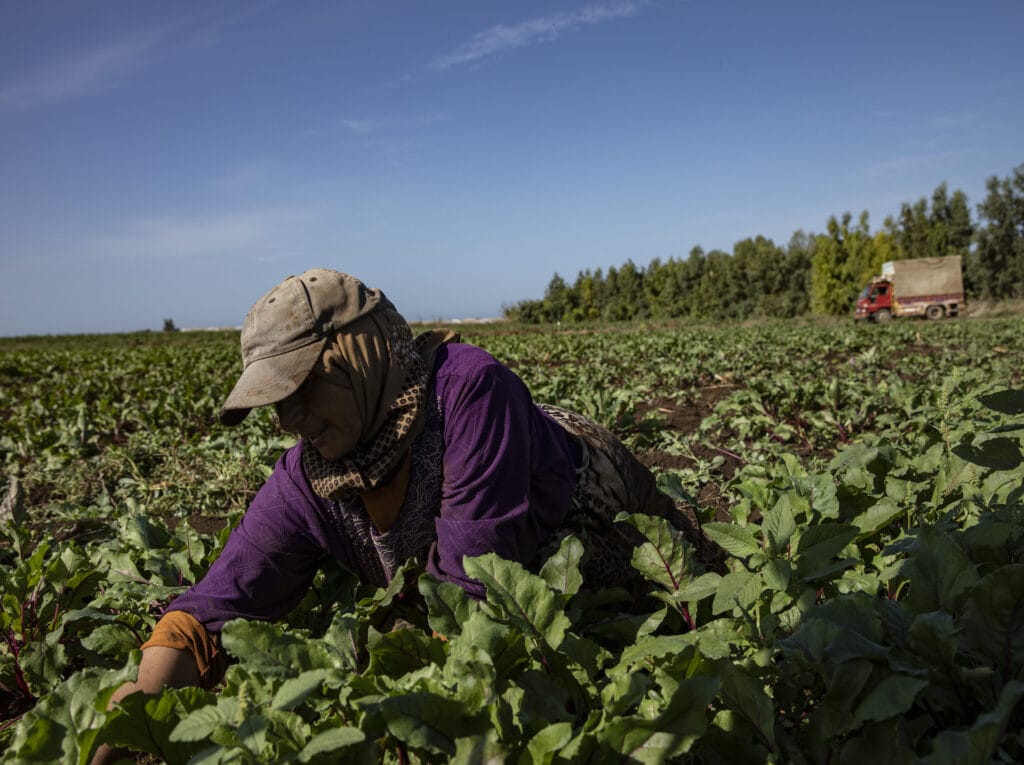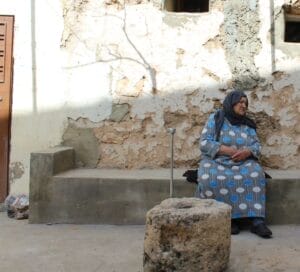
The agricultural sector in shambles
Despite contributing in a derisory way to the overall GDP, agriculture plays a significant role in some of the poorest regions of Lebanon. In Akkar and North Bekaa, where the climate is moderate, the soil rich, and water resources abundant, agriculture-related activities account for up to 80 percent of the local GDP.[1]
The outbreak of the Syrian war not only meant a considerable influx of Syrians into the country – it is estimated that Lebanon currently hosts around 1.5 million Syrian refugees – but also ushered in negative repercussions on the agriculture and food sectors in Lebanon due to disruption of trade routes as well as higher costs. It is, moreover, worth remembering that agriculture is one of the few sectors where Syrians are allowed to work, which resulted in Syrian labour being paid less than the Lebanese one, hence creating increasing tensions between the refugees and the host communities due to growing competition over lower-skilled jobs.
The hardships of the Lebanese farmers

In the past couple of years, the advent of the economic crisis has worsened even more the condition of the farmers living in those regions. In occasion of the Focus Group Discussions held in December 2020, the farmers expressed the hardship they are now enduring. As mentioned in the first article of this series , due to the economic crisis the inflation rate skyrocketed. In a country where the US dollar is the main currency of reference, this means that every transaction is pegged to the American currency. This also includes the agricultural sector. Generally, the inputs, i.e. seedlings, fertilizers, agricultural equipment, fuel, are imported from the international market. Moreover, some of those can only be purchased in dollars.
Before the crisis, in order to procure fertilizers for their crops farmers used to borrow money, which they would pay back after the harvest was sold. With the economic crisis and the lack of financial liquidity, they cannot adopt this practice anymore. In fact, the costs of the imported outputs are soaring as they are all pegged to the black market exchange rate of the Lebanese Pound (LBP 15,000/1$ as of March 2021), meanwhile the farmers have to sell their products in accordance with the currency’s official exchange rate (LBP 1,500), and are thus suffering huge losses.
The inability to buy the necessary inputs results in numerous rural households, particularly those whose main source of income is crop production, having to depend completely on external aid. The farmers interviewed stated that nowadays they have to rely on international and national associations for support on seedlings, seeds and pesticides distribution. In general, the agricultural sector is subjected to a state of neglect, as there are no incentive schemes from the side of the Lebanese government. No soft loans are provided to the farmers interviewed.

If, on the one hand, crop production has been impacted in terms of quantity available and the annual yields are at risk this year, on the other hand, many farmers, especially in Northern Bekaa, have decided to switch to different types of crops. The reason being the difficulty in water extraction. Even though underground water is relatively shallow, the high expenses of fuel to pump water is making it impossible for farmers to use this rich resource. Most farmers have stopped planting vegetables and fruits, which are water demanding, and have hence resorted to rainfed agriculture, such as planting wheat, hordeum, olive trees…
Coping with the crises
In light of the current state of affairs, it becomes clear why agriculture is not profitable anymore. Inevitably, the repercussions on the rural households’ income are dramatic. Despite the high inflation, farmer’s salaries remained the same even after the crisis, resulting in a 90% loss of their purchase power.
Seeing that they are not able to afford a dignified living any longer, coping mechanisms emerge. For instance, some farmers admitted having stopped buying meat, chicken and fish, and having resorted to buying only basic food items, such as bread, lentils, seasonal vegetables. The interviewees also mentioned an increasing indebtness with friends, shopkeepers or even strangers.
Furthermore, with the kids out of school due to COVID-19 pandemic, farmers acknowledged having to rely also on their children to support the work on the field. Indeed, the shrinking income means that farmers do not have the means to pay for their daily workers’ wages anymore.
Consequently, a considerable number of Syrian refugees who appear to be the ones mainly employed in the agricultural sector are left without a daily wage. Figures from the 2020 update of the Vulnerability Assessment of Syrian Refugees (VASyR) report reveal how, compared to last year, there has been an 8-percentage point increase in unemployment rate[2]. Behind the reasons of unemployment, the majority of refugees mentioned the lack of job opportunities, particularly in the Bekaa (30%) and in Akkar (28%)[3]. More and more Syrian refugee households are, therefore, incapable of earning a living wage. Indeed, estimates show that 89% of such households are currently living in extreme poverty, with the highest levels of households under the Survival and Minimun Basket level reported in Bekaa (96%) and Baalbek-El Hermel (94%).[4] Food-insecure Syrian refugees, akin to Lebanese farmer households, are resorting to negative coping mechanisms, like reducing the number of their meals, limiting the intake of key nutrients, buying only basic food items…
Two communities: shared concerns
The economic recession that Lebanon is facing caused income reductions, large-scale job losses, steady inflation, an increase in pre-existing vulnerabilities and many other issues. These impacts were further aggravated by the recent Covid-19 restrictions put in place to curb the spread of the disease. This is still translating into an unsustainable situation faced by most Syrian and Lebanese communities in WW-GVC’s Area of Intervention - North Bekaa and Akkar. In fact, it has become clear how, across all the assessed groups in several geographic areas, both Syrian and Lebanese communities share the main issues and concerns and highlight the need for reforms.
**Cover photo: A Syrian woman working in a field in North Bekaa.
© Francesca Volpi
**We are operating under the ECHO-funded Lebanon Protection Consortium to provide support to the Syrian refugees in North Bekaa and Akkar**
[1] Lebanon at a glance, FAO.
[2] Vulnerability Assessment of Syrian Refugees, VASyR, 2020, p. 12.



